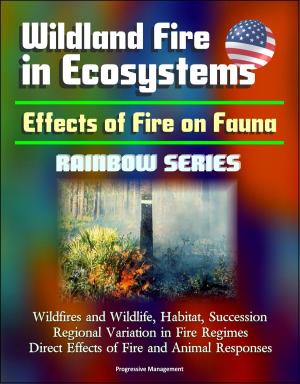Complete Guide to NASA's Mars Science Laboratory (MSL) Project - Mars Exploration Curiosity Rover, Radioisotope Power and Nuclear Safety Issues, Science Mission, Inspector General Report
Nonfiction, Science & Nature, Science, Physics, Cosmology, Astronomy| Author: | Progressive Management | ISBN: | 9781465831057 |
| Publisher: | Progressive Management | Publication: | November 16, 2011 |
| Imprint: | Smashwords Edition | Language: | English |
| Author: | Progressive Management |
| ISBN: | 9781465831057 |
| Publisher: | Progressive Management |
| Publication: | November 16, 2011 |
| Imprint: | Smashwords Edition |
| Language: | English |
Comprehensive coverage of all aspects of NASA's Mars Science Laboratory (MSL) and its Curiosity rover, scheduled for launch on an Atlas rocket in late November 2011, is provided in this unique compilation of official NASA material. There is complete data on the MSL mission, science investigations, historical Mars missions, the Gale Crater landing site, the radioisotope nuclear power source and nuclear safety issues surrounding its use - including radiological contingency planning and launch hazards, and much more.
Contents include: Mars at a Glance * Mars Science Laboratory Investigations * Mission Overview * Mars Science Laboratory Landing Site * Recent, Current and Upcoming Missions * Mars Science: A Story of Changes * Historical Mars Missions * Program/Project Management * Science payload with ten instruments: Alpha Particle X-ray Spectrometer, Chemistry and Camera, Chemistry and Mineralogy, Dynamic Albedo of Neutrons, Mars Descent Imager, Mars Hand Lens Imager, Mast Camera, Radiation Assessment Detector, Rover Environmental Monitoring Station, and Sample Analysis at Mars.
As a supplement, the status report on MSL issued by the NASA Office of Inspector General in 2011 is included in this compilation.
The Mars Science Laboratory (MSL), part of the Science Mission Directorate’s Mars Exploration Program (Mars Program), is the most technologically challenging interplanetary rover ever designed. This NASA flagship mission, whose life-cycle costs are currently estimated at approximately $2.5 billion, will employ an array of new technologies to adjust its flight while descending through the Martian atmosphere, including a sky crane touchdown system that will lower the rover on a tether to the Martian surface.
NASA's Mars Science Laboratory mission will study whether the Gale Crater area of Mars has evidence of past and present habitable environments. These studies will be part of a broader examination of past and present processes in the Martian atmosphere and on its surface. The research will use 10 instrument-based science investigations. The mission's rover, Curiosity, carries the instruments for these investigations and will support their use by providing overland mobility, sample-acquisition capabilities, power and communications. The primary mission will last one Mars year (98 weeks).
The payload includes mast-mounted instruments to survey the surroundings and assess potential sampling targets from a distance; instruments on Curiosity's robotic arm for close-up inspections; laboratory instruments inside the rover for analysis of samples from rocks, soils and atmosphere; and instruments to monitor the environment around the rover. In addition to the science payload, engineering sensors on the heat shield will gather information about Mars' atmosphere and the spacecraft's performance during its descent through the atmosphere.
To make best use of the rover's science capabilities, a diverse international team of scientists and engineers will make daily decisions about the rover's activities for the following day. Even if the rover's technology all performs flawlessly, some types of evidence the mission will seek about past environments may not have persisted in the rock record. While the possibility that life might have existed on Mars provokes great interest, a finding that conditions did not favor life would also pay off with valuable insight about differences and similarities between early Mars and early Earth.
Comprehensive coverage of all aspects of NASA's Mars Science Laboratory (MSL) and its Curiosity rover, scheduled for launch on an Atlas rocket in late November 2011, is provided in this unique compilation of official NASA material. There is complete data on the MSL mission, science investigations, historical Mars missions, the Gale Crater landing site, the radioisotope nuclear power source and nuclear safety issues surrounding its use - including radiological contingency planning and launch hazards, and much more.
Contents include: Mars at a Glance * Mars Science Laboratory Investigations * Mission Overview * Mars Science Laboratory Landing Site * Recent, Current and Upcoming Missions * Mars Science: A Story of Changes * Historical Mars Missions * Program/Project Management * Science payload with ten instruments: Alpha Particle X-ray Spectrometer, Chemistry and Camera, Chemistry and Mineralogy, Dynamic Albedo of Neutrons, Mars Descent Imager, Mars Hand Lens Imager, Mast Camera, Radiation Assessment Detector, Rover Environmental Monitoring Station, and Sample Analysis at Mars.
As a supplement, the status report on MSL issued by the NASA Office of Inspector General in 2011 is included in this compilation.
The Mars Science Laboratory (MSL), part of the Science Mission Directorate’s Mars Exploration Program (Mars Program), is the most technologically challenging interplanetary rover ever designed. This NASA flagship mission, whose life-cycle costs are currently estimated at approximately $2.5 billion, will employ an array of new technologies to adjust its flight while descending through the Martian atmosphere, including a sky crane touchdown system that will lower the rover on a tether to the Martian surface.
NASA's Mars Science Laboratory mission will study whether the Gale Crater area of Mars has evidence of past and present habitable environments. These studies will be part of a broader examination of past and present processes in the Martian atmosphere and on its surface. The research will use 10 instrument-based science investigations. The mission's rover, Curiosity, carries the instruments for these investigations and will support their use by providing overland mobility, sample-acquisition capabilities, power and communications. The primary mission will last one Mars year (98 weeks).
The payload includes mast-mounted instruments to survey the surroundings and assess potential sampling targets from a distance; instruments on Curiosity's robotic arm for close-up inspections; laboratory instruments inside the rover for analysis of samples from rocks, soils and atmosphere; and instruments to monitor the environment around the rover. In addition to the science payload, engineering sensors on the heat shield will gather information about Mars' atmosphere and the spacecraft's performance during its descent through the atmosphere.
To make best use of the rover's science capabilities, a diverse international team of scientists and engineers will make daily decisions about the rover's activities for the following day. Even if the rover's technology all performs flawlessly, some types of evidence the mission will seek about past environments may not have persisted in the rock record. While the possibility that life might have existed on Mars provokes great interest, a finding that conditions did not favor life would also pay off with valuable insight about differences and similarities between early Mars and early Earth.















